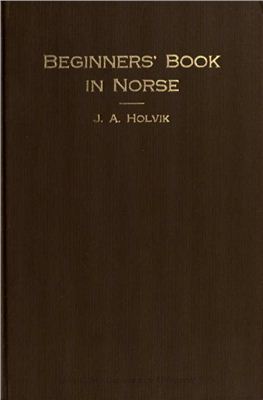Издательствоr: Augsburg Publishing House - Minneapolis
Год: 1910
Количество страниц: 360
THIS book aims to give the English-speaking student a reading knowledge and to some extent a speaking knowledge of present-day Norse. It lays no claim to being a complete treatise on Norse grammar. Only such principles and details of grammar are presented as were thought necessary to make plain the differences between Norse and English.
The book is chiefly intended for the classroom, and much is left to the instructor, especially drill and review work, pronunciation, and conversation. However, it is hoped that anyone wishing to acquire a knowledge of elementary Norse, who has no access to a classroom course, will derive some benefit from the book in private study. The exact intonation, however, can only be gotten from the spoken word.
As to the plan of the book, but little need be said. The vocabulary of each lesson aims to give a group of words which are associated with one another in common use. These words are then used in the reading exercise, in somewhat connected discourse. The composition exercises are made up chiefly of detached sentences, applying as much as possible the principles presented in the respective lessons. It was planned to take up literature as early as possible, to fuish the desired element of interest. Beginning with
Lesson XXXVI, the reading exercises consist of Bj0son's little classic, "En glad gut." The vocabularies and the composition and conversation exercises are based on the text.
As a beginners' book in Norse for English-speaking students is to some extent a new venture, the author keenly realizes the possibility of many points of deficiency. In view of this, he sincerely requests criticism and suggestions for improvement. Arrangements are made for any such revision as may prove necessary.
"Norse" has been used throughout in place of the cumbersome and much mispronounced "Norwegian." To many this may be slightly confusing as Norwegian is more commonly used. A discussion on the respective merits and correctness of these terms would lead too far. Suffice it to say that present usage among writers and authorities shows that Norse is rapidly supplanting Norwegian; and rightly so.
Год: 1910
Количество страниц: 360
THIS book aims to give the English-speaking student a reading knowledge and to some extent a speaking knowledge of present-day Norse. It lays no claim to being a complete treatise on Norse grammar. Only such principles and details of grammar are presented as were thought necessary to make plain the differences between Norse and English.
The book is chiefly intended for the classroom, and much is left to the instructor, especially drill and review work, pronunciation, and conversation. However, it is hoped that anyone wishing to acquire a knowledge of elementary Norse, who has no access to a classroom course, will derive some benefit from the book in private study. The exact intonation, however, can only be gotten from the spoken word.
As to the plan of the book, but little need be said. The vocabulary of each lesson aims to give a group of words which are associated with one another in common use. These words are then used in the reading exercise, in somewhat connected discourse. The composition exercises are made up chiefly of detached sentences, applying as much as possible the principles presented in the respective lessons. It was planned to take up literature as early as possible, to fuish the desired element of interest. Beginning with
Lesson XXXVI, the reading exercises consist of Bj0son's little classic, "En glad gut." The vocabularies and the composition and conversation exercises are based on the text.
As a beginners' book in Norse for English-speaking students is to some extent a new venture, the author keenly realizes the possibility of many points of deficiency. In view of this, he sincerely requests criticism and suggestions for improvement. Arrangements are made for any such revision as may prove necessary.
"Norse" has been used throughout in place of the cumbersome and much mispronounced "Norwegian." To many this may be slightly confusing as Norwegian is more commonly used. A discussion on the respective merits and correctness of these terms would lead too far. Suffice it to say that present usage among writers and authorities shows that Norse is rapidly supplanting Norwegian; and rightly so.

